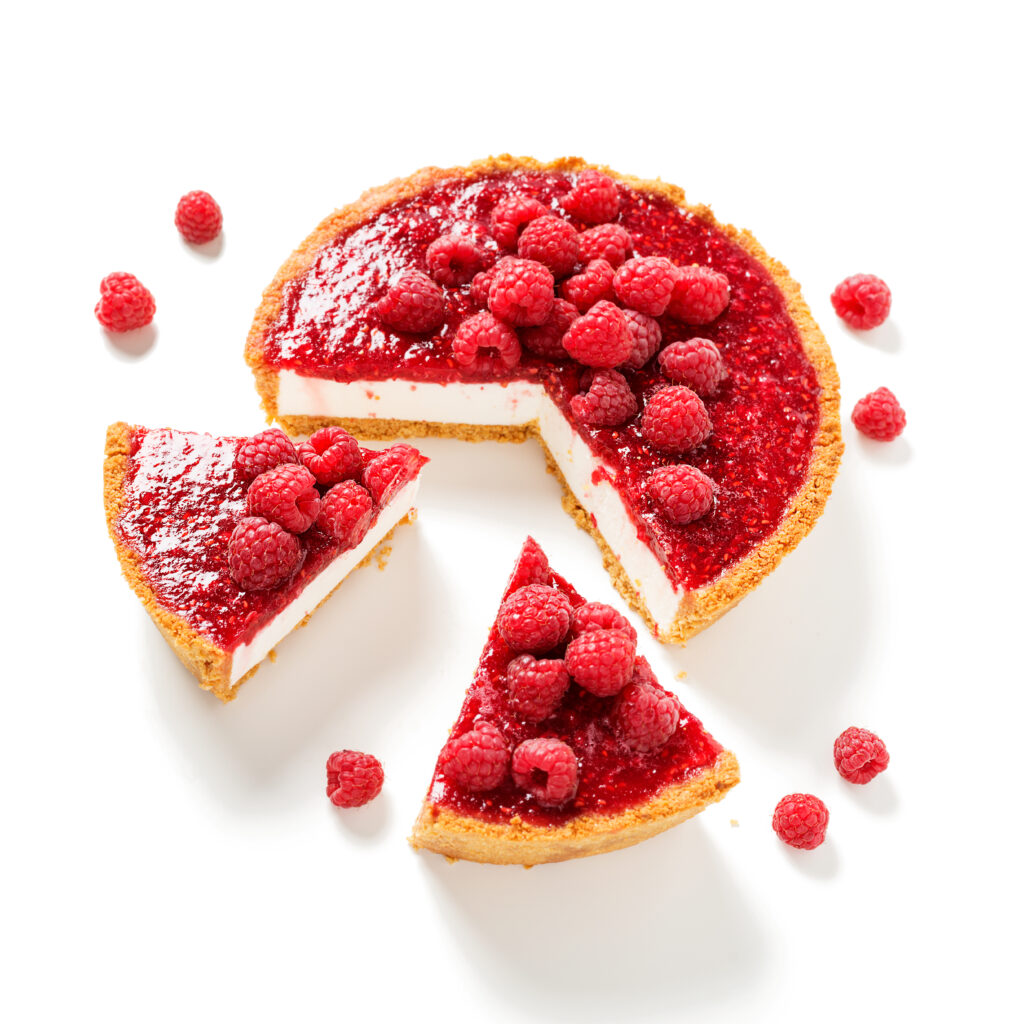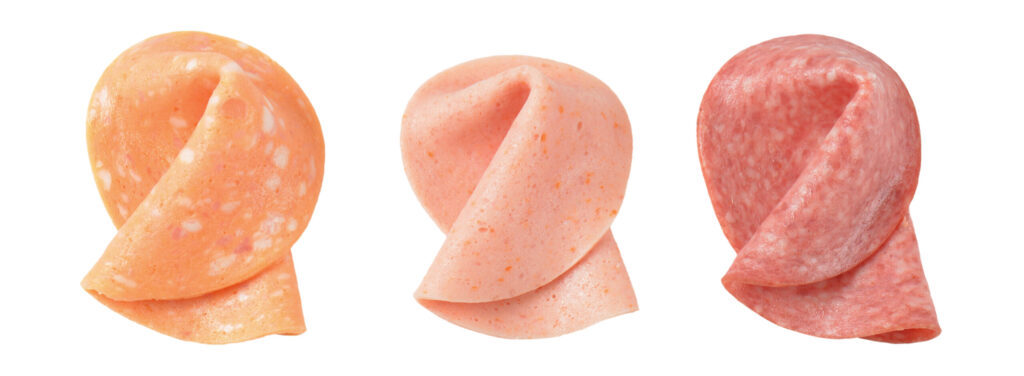READ ALL ABOUT APPLICATIONS IN THE NEXT CHAPTER
All About Carrageenan
Carrageenan
REFINED AND SEMI-REFINED CARRAGEENAN
Carrageenan, refined (E407) or semi refined (E407a), is traditionally used to bind water and provide texture in a cooked food system. Carrageenan, refined (E407) or semi-refined (E407a), is traditionally used to bind water and provide texture in cooked foods. Traditionally, Kappa and Iota carrageenan dissolves during heat treatment and form a thermally reversible gel during the subsequent cooling. The carrageenan dosage/application rate and liquid ratio determine the amount of liquid that can bind and the final textural properties of the finished product.
Both refined carrageenan (E407) and semi-refined carrageenan (E407a) can be used in vegan and/or organic foods, depending on local regulations.
In many applications, carrageenan can do much more than just bind water. It can also:
- Provide a specific texture
- Increase sliceability
- Give body to the product, e.g. as a fat replacer
- Improve flavour release
- Provide freeze/thaw stability
LEGISLATION
Carrageenan is extracted from a class of red seaweeds known as Rhodophyceae. It is considered to be a texturising ingredient and can be used in quantum satis (in the required amount) in many food products worldwide.
Refined and semi-refined carrageenan are approved as carrageenan under FDA (regulations 21 CFR 172.620, 172.626) and Food Chemicals Codex standards.
In Europe, refined carrageenan is approved as E407 and semi-refined carrageenan is approved as E407a according to the EU Regulation 2012/231/EU, Code of Federal Regulations and Food Chemicals Codex standards.
SOURCE
As described before, carrageenan is an extract from red seaweeds. One of the determinants of the type and functionality of carrageenan is the species of seaweed.
Eucheuma cottonii is a cultivated warm water algae species commonly used in the production of Kappa-type carrageenan. Kappa carrageenan provides a firm and rigid gel.
Eucheuma spinosum is a cultivated warm water algae species commonly used in the production of Iota-type carrageenan. Iota-carrageenan produces a soft and elastic gel.
Chondrus crispus and Gigartina skottsbergii species of broad leaf and narrow leaf are examples of naturally grown cold water algae commonly used in the production of Lambda. Lambda-carrageenan usually contains a compound fraction of Kappa, Iota, and Lambda sequences in the same molecule. The proportion of each sequence varies depending on the algae species, the age of the algae, and the processing method. The texture of lambda-carrageenan varies from a relatively solid gel to a very viscous solution.
Furcellaria is a naturally growing cold-water seaweed used in the production of furcelleran. Furcelleran gives a semi-solid and rigid gel.
Warm water algae are sown and harvested in farms with stable water temperatures and tidal water that provides nutrients to the algae. Cold water seaweeds are harvested from boats or collected on the beach after being washed ashore. The age of the seaweed is an important factor when assessing the performance of the final product. Both cold-water and warm-water seaweed species are dried either in the sun or in hot air and transported to their production sites.
PRODUCTION
Carrageenan production can be divided into two main processes:
- a process in the production of refined carrageenan
- a process in the production of semi-refined carrageenan.
To obtain refined carrageenan, dried seaweed is washed and treated with hot temperature and alkaline solution. The carrageenan is extracted from the cellulose in the seaweed. This solution is filtered to remove the insoluble cellulose (also called fibre and/or acid-insoluble matter [ AIM ]) and other impurities. The cellulose + minerals obtained from the process + filter aids are typically used to fertilise fields in local areas. The hot carrageenan solution contains a large amount of water. The water is usually removed by:
Centrifugal and evaporation process. The water is drawn off from the carrageenan slurry by centrifugation; the remaining water is evaporated by hot air. The resulting dry material is milled into carrageenan powder.
Addition of KCl. The addition of KCl causes the hot solution to gel and produce a syneresis. The gel is pressed into a semi-dry “material”. This material is dried in hot air and then milled into carrageenan powder.
Precipitation. Alcohol is added to the carrageenan slurry. The carrageenan molecules precipitate into long fibres. These fibres are then filtered off, dried in hot air, and milled into carrageenan powder.
Each process has its own unique advantages and characteristics, as some processes allow ion exchange and some processes are only applicable to certain types of algae.
In the case of the semi-refining process, the dried seaweed is washed and modified using a medium high temperature and alkali. The process treats the carrageenan with alkali inside the cellulose matrix in the seaweed. After this process, the water and processing aids are filtered out of the semi-refined carrageenan. The semi-refined carrageenan is dried in hot air and then milled into semi-refined carrageenan powder.
For both processes, refined and semi-refined, the level of alkali treatment can be controlled and modified. Additional washing, ion exchange, and bleaching processes can be combined with the basic processes mentioned above.
MOLECULE
As mentioned above, carrageenan is a sulphated galactose chain with a varying number of sulphate groups in descending order from low to high.
- Furcelleran
- Kappa carrageenan
- Iota carrageenan
- Lambda carrageenan
The carrageenan chain consists of two galactose hexanuclear rings linked by Beta 1->4 and Alpha 1 ->3 bonds. Prior to treatment with alkali, the sulphate groups are located in the C2 and C4 sub-ring and in the C2, C6 beta ring, depending on the algae type.
During alkaline treatment, oxygen bridges are formed between the beta ring C3 and C6, at least on Kappa and Iota carrageenan. The sulphate group placed on C6 is sacrificed during this process. At the same time, the beta ring changes its orientation, allowing the carrageenan molecule to form a double helix during cooling. The degree of alkali modification can be varied to achieve the desired texture and solubility. There are two fundamental rules of thumb:
The higher the number of sulphate groups, the better the solubility, which means lower dissolution temperature but also weaker gel texture.
The lower the number of sulphate groups, the lower the solubility, which means a higher dissolution temperature, but also a stronger gel structure.
Gelling salt + synergistic gums
Carrageenan cannot achieve its maximum functionality without gelling ions, known in practice as gelling salts. Some gelling salts are more effective than others, e.g. KCl is very effective in increasing the gel strength of Kappa-carrageenan and CaCl2 increases the gel strength of Iota-carrageenan. The preferred gelling ions for the four types of carrageenan are listed below in descending order:
Furcelleran: K+, Ca++, Mg++, Na+
Kappa carrageenan: K+, Ca++, Mg++, Na+
Iota carrageenan: Ca++, K+, Mg++, Na+
Lambda carrageenan: Ca++, K+, Mg++, Na+ or K+, Ca++, Mg++, Na+, depending on the proportion of Iota or Kappa fraction in the product.
When carrageenan is combined with other ingredients, something extra is obtained. This can be explained by both a supportive and a synergistic effect. The differences between these effects are explained here:
Supportive effect: Starch, guar gum and xanthan gum do not chemically interact with the carrageenan molecule, but they can optimise the distribution of the carrageenan powder during cooking and cooling and thus give a better end result.
Synergistic effect: is a positive or negative interaction between two elements. The synergistic effect of carrageenan is related to Kappa fractions and other hydrocolloids or proteins. This refers to positive synergism or positive interaction between the oxygen bridges of the Kappa-carrageenan double helix, which may interact with other gums or proteins, e.g. with a divalent salt. Typical examples include:
Kappa carrageenan + Konjac gum
Kappa carrageenan + Locust bean gum
Kappa carrageenan + Casein + Ca++ (depending on the isoelectric point of the protein)

MAIN FUNCTIONALITY IN APPLICATIONS
The main function of carrageenan is to bind water. Subsequently, it may have a secondary function to modify the texture of the gel as required. All carrageenans are stable and easy to use in a wide range of applications:
- pH
- Salts
- Sugar
- Alcohol
This makes carrageenan suitable for use in most common foods or other non-food products where water content needs to be controlled.
STANDARDISATION
EUROGUM standardises carrageenans to ensure and guarantee uniform product performance. Carrageenan is a natural product, and it is our expertise that allows us to consistently meet the specification without deviation. The performance of our products in your processes and finished products will remain consistent from batch to batch.
PRODUCT RANGE
The performance of carrageenan products depend, among other things, on:
- The type of algae
- Age of the algae
- Degree of alkali modification
- Ionic composition
- Bleaching
- Powder mesh size
- Additional gelling salts
- Additional synergistic/supporting gums
All these factors need to be taken into account when developing a new product. This product can be the result of matching an existing product or a new product developed from scratch. EUROGUM specialises in the production of customised blends for all applications with short lead times to meet the requirements of all our customers.

